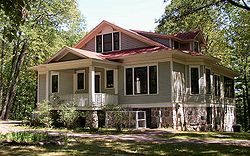Charles A. Lindbergh State Park
|
Charles A. Lindbergh House and Park
|
|

The boyhood home of aviator Charles Lindbergh stands in the park donated in memory of his father.
|
|
| Location | 1620 Lindbergh Dr. S |
|---|---|
| Nearest city | Little Falls, Minnesota |
| Coordinates | 45°57′26.78″N 94°23′23.24″W / 45.9574389°N 94.3897889°WCoordinates: 45°57′26.78″N 94°23′23.24″W / 45.9574389°N 94.3897889°W |
| Built | 1906 |
| Architect | Carl Bolander |
| NRHP Reference # | 70000303 |
| Significant dates | |
| Added to NRHP | November 20, 1970 |
| Designated NHL | December 8, 1976 |
|
Charles A. Lindbergh State Park WPA/Rustic Style Historic Resources
|
|

Water tower and picnic shelter, constructed 1938
|
|
| Location | Pike Creek Township |
|---|---|
| Coordinates | 45°57′28″N 94°23′26″W / 45.95778°N 94.39056°W |
| Area | 9 acres (3.6 ha) |
| Built | 1938–39 |
| Architect | National Park Service, State of Minnesota, Works Progress Administration |
| Architectural style | NPS Rustic |
| MPS | Minnesota State Park CCC/WPA/Rustic Style MPS |
| NRHP Reference # | 89001655 |
| Added to NRHP | 1989-10-25 |
Charles A. Lindbergh State Park is a 569-acre (2.3 km²) Minnesota state park on the outskirts of Little Falls. The park was once the farm of Congressman Charles August Lindbergh and his son Charles Lindbergh, the famous aviator. Their restored 1906 house and two other farm buildings are within the park boundaries. The house, a National Historic Landmark, and an adjacent museum are operated by the Minnesota Historical Society. Three buildings and three structures built by the Works Progress Administration in the 1930s were named to the National Register of Historic Places. These buildings include a picnic shelter and a water tower, built in the Rustic Style from local stone and logs, and have remained relatively unchanged since construction. Although the property includes shoreline on the Mississippi River, the Lindbergh family requested that the park not include intensive use areas for swimming or camping, so development was kept to a minimum.
Charles August Lindbergh, known as C.A., was a prominent lawyer and real estate trader in Little Falls. In March 1901 he married Evangeline Lodge Land, the college-educated descendant of two notable Detroit medical families, who had come to Little Falls the previous autumn as a teacher. She, C.A., and his two daughters from a previous marriage moved to a property, which C.A. had purchased for a dairy farm three years earlier. They had a three-story house built on the bluff overlooking the Mississippi River. A tenant's house was built across the road for the farm workers. Charles Augustus Lindbergh was born in 1902, and would be the couple's only child. A barn was built later that year, and the farm was populated with cattle, goats, hogs, sheep, chickens, and pigeons as well as cats and dogs.
On August 5, 1905 a fire started for unknown reasons on the third floor. The house burned down to its stone foundation, but the Lindberghs and their servants escaped injury and managed to save many of the household items. The Lindberghs had a new house built on the foundation of the first. However it was much smaller, due to C.A.'s overextended finances and a growing strain in the marriage. The new house fit awkwardly onto the footprint of the old, necessitating a short hallway with seven doors leading off. The basement, intended as a library for C.A., and the upper floor was never finished. Instead, C.A. entered politics and in 1907 began serving the first of five consecutive terms in the U.S. House of Representatives. For the next decade the younger Charles spent much of each year in Detroit and Washington, D.C., leaving only two or three months at the house in Little Falls. However, Charles would credit his time spent on the farm and playing along the Mississippi for his strength and self-reliance. The unfinished upper floor became Charles' exclusive play area, and upon hearing an unusually loud engine one day in 1911 he climbed out onto the roof and saw his first airplane.
...
Wikipedia


